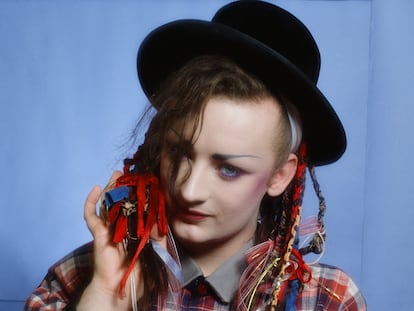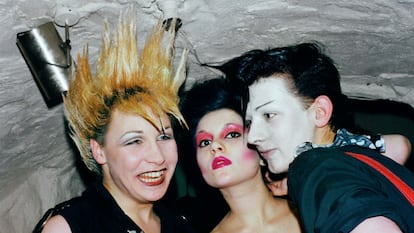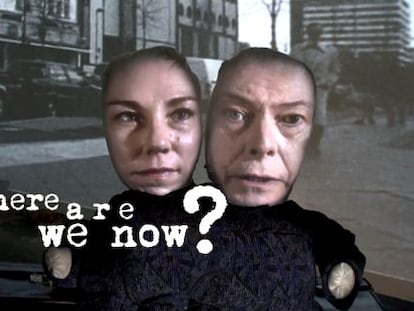Why Boy George was the first hipster: The Blitz club’s incredible history
Netflix’s documentary ‘Blitzed!’ reminds us that, long before today’s non-binary club-goers in second-hand clothes, the New Romantics were redefining fashion from a position of precariousness. Their influence endures today

Once upon a time, as a discontented England approached the 1980s, nightlife culture became a revolt, an assault weapon, a playful gesture of protest against Margaret Thatcher’s iron fist. Clubbing as we know it today was born during those days, when punk nihilism gave way to a much more colorful form of subversion. The ashes of glam, a reaction to the American disco movement and David Bowie’s futurism laid the foundations of The Blitz, a small London club that served as a late-night refuge for art and fashion school students and working-class Dadaists who had raided their mothers’ vanities. The club barely lasted 18 months, between 1979 and 1980, but it was the epicenter of a life philosophy that endures today through the gender-fluid club-goers who dress in second-hand clothes and own the night.
Netflix’s documentary Blitzed! explores the history of the British club via testimonies from some of its most distinguished surviving habitués, including singer Boy George, Spandau Ballet guitarist Gary Kemp and acclaimed Game of Thrones costume designer Michele Clapton. Chrissie Hynde (The Pretenders), Adam Ant, Billy Idol, Siobhan Fahey (Bananarama), Sade and John Galliano all cut their teeth there.

The Blitz’s most important figure was Steve Strange, who later became half of the band Visage, which sung Fade to Grey, a number-one hit song in much of Europe. Along with the group’s eventual drummer, Rusty Egan, Strange took over a bistro in London’s depressed Covent Garden area and founded The Blitz, a club that emulated the atmosphere of 1930s Germany’s decadent clubs.
Unlike New York’s Studio 54, where everything was about sex, cocaine and celebrities, The Blitz boasted androgyny, amphetamines and an underground spirit. While Egan experimented in the DJ booth and invented new ways of dancing to Bowie, Roxy Music and Kraftwerk, Strange guarded the door. When someone’s look didn’t pass muster, he told them to “go home, make an effort.” He liked to say that “here men have to get dressed up as much as women do; it doesn’t matter whether they cultivate an Edwardian or Dickensian or whatever style.” When Mick Jagger was seduced by the lure of the new subculture and wanted to enter the club, Strange turned him away, blurting out, “Sorry, you’re not dressed up enough.” In the documentary, Boy George recalled his late frenemy, with whom he spent many nights competing for the spotlight. “Nobody kicks the world’s biggest rock star out of anywhere. It was a big publicity stunt. Steve was great at that kind of thing.”

Before Culture Club, George worked at a fashion store called Boy, and was known to be a kleptomaniac who stole money from The Blitz’s coat-check closet, where he also had a job. Michele Clapton, today a costume designer, remembers the club’s extremely competitive environment: “It wasn’t worth saying, ‘I’m not making the effort today,’ because then you knew your outfit was going to be the subject of others’ snarky comments. Even if you didn’t have money, you had to be creative.”
At the time, Boy George was squatting in a house on Warren Street with Stephen Jones. A student at St. Martins, Jones became a mad hatter who ended up making chapeaus for the Queen of England herself. “If you came up with anything related to street culture at school, you earned a zero. Logically, the opposite effect occurred: we rebelled against academicism and took to the streets,” he says.
Jones summarizes the ritual as follows: “The nights started two days before. You’d plan your look, go to Oxfam’s second-hand clothing stores, reinventing clothes as you went along, exasperatedly rummaging through your closet. After primping for at least two hours, you’d get on the subway, trusting that no one would beat you up on the way. Once at the club, you would ruthlessly judge each other’s outfits, trying to figure out what the hell we meant by them. You ordered the cheapest drink, tried to make it last as long as possible, and didn’t let go in case it got snatched. And from then on, it was all about posing for hours and dancing like robots. But the real action was in the bathrooms. Sex, drugs, drama... The explosion of press coverage on the trend rode that wave,” he explains with a chuckle.
The Blitz’s decline may have begun with the visit of the hero who had inspired it in the first place: one night, Bowie went there looking for people to appear in his Ashes to Ashes music video and copied the gothic Pierrot look. The media arrived, and the movement was given a proper name: Blitz Kids, new dandies, the Nameless Cult... Richard James Burgess, Spandau Ballet’s first producer, gave them the headline: the New Romantics. The iconic band was the first to perform at The Blitz. As guitarist Gary Kemp recalls: “Nobody there wanted to see a band play, they just wanted to look at each other; they were just ordinary kids wanting to be the biggest thing in the room. But we knew that every youth movement in pop culture has always had its representative band. And, as presumptuous as it sounds, we said to ourselves, this is our chance.” Chris Blackwell, the founder of Island Records, was there, and he signed them that same night. Within six months, Spandau Ballet was performing on Top of the Pops dressed as space pirates.
The fashion industry also jumped onto the bandwagon. TopShop copied the New Romantic essence in its collections. The alternative scene was no longer alternative. As Gary Kemp recalls: “Suddenly these clothes were everywhere. Lady Di was wearing ruffle-collared blouses and bloomers: the same stuff that these weird people were wearing when The Blitz opened was now being worn by the royal family. That’s part of its success and its failure; because it stops being special and loses the mystique but, on the other hand, that’s what we were looking for, to transcend.”
Stephen Jones attributes the phenomenon’s global spread (and decline) to “the clash between fashion and the advent of music videos.” Amid Culture Club’s Do You Really Want to Hurt Me, Jean Paul Gaultier first saw the milliner Jones, crowned with a gorgeous Turkish fez. He immediately called him and made him one of his essential collaborators. Vivienne Westwood, Thierry Mugler and Claude Montana did the same. Fashion designer John Galliano, another superstar from St. Martins and the line at the Blitz bathroom, asked Jones to join him in raising the bar for extravagance when the former was signed by the house of Dior in 1996. But that story is far removed from the underground.
Sign up for our weekly newsletter to get more English-language news coverage from EL PAÍS USA Edition
Tu suscripción se está usando en otro dispositivo
¿Quieres añadir otro usuario a tu suscripción?
Si continúas leyendo en este dispositivo, no se podrá leer en el otro.
FlechaTu suscripción se está usando en otro dispositivo y solo puedes acceder a EL PAÍS desde un dispositivo a la vez.
Si quieres compartir tu cuenta, cambia tu suscripción a la modalidad Premium, así podrás añadir otro usuario. Cada uno accederá con su propia cuenta de email, lo que os permitirá personalizar vuestra experiencia en EL PAÍS.
¿Tienes una suscripción de empresa? Accede aquí para contratar más cuentas.
En el caso de no saber quién está usando tu cuenta, te recomendamos cambiar tu contraseña aquí.
Si decides continuar compartiendo tu cuenta, este mensaje se mostrará en tu dispositivo y en el de la otra persona que está usando tu cuenta de forma indefinida, afectando a tu experiencia de lectura. Puedes consultar aquí los términos y condiciones de la suscripción digital.
More information
Archived In
Últimas noticias
Most viewed
- Reinhard Genzel, Nobel laureate in physics: ‘One-minute videos will never give you the truth’
- Oona Chaplin: ‘I told James Cameron that I was living in a treehouse and starting a permaculture project with a friend’
- Pablo Escobar’s hippos: A serious environmental problem, 40 years on
- Why we lost the habit of sleeping in two segments and how that changed our sense of time
- Chevy Chase, the beloved comedian who was a monster off camera: ‘Not everyone hated him, just the people who’ve worked with him’









































